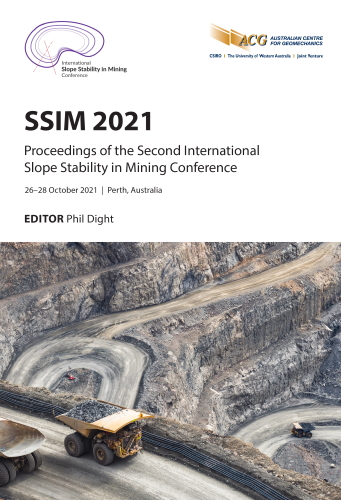Improving the geostatistical modelling of geotechnical variables considering directional dependence

|
Authors: Sánchez, LK; Emery, XM; Séguret, SA |
DOI https://doi.org/10.36487/ACG_repo/2135_25
Cite As:
Sánchez, LK, Emery, XM & Séguret, SA 2021, 'Improving the geostatistical modelling of geotechnical variables considering directional dependence', in PM Dight (ed.), SSIM 2021: Second International Slope Stability in Mining, Australian Centre for Geomechanics, Perth, pp. 401-412, https://doi.org/10.36487/ACG_repo/2135_25
Abstract:
Together with geological and geometallurgical modelling, geotechnical modelling is one of the essential components for the planning and development of open pit and underground mining projects. A particular characteristic of many geotechnical variables is to be direction-dependent, i.e. the measurement of a core sample not only depends on the geographical position of this sample, but also its orientation. To account for this characteristic, it is proposed to regionalise such variables in a five-dimensional space corresponding to the product on the three-dimensional geographical space and the two-dimensional sphere, so that each measurement is indexed by its easting, northing, elevation, azimuth, and dip. Instead of making predictions and simulations conditioned to a particular direction, this new paradigm allows geotechnical variables to be interpolated at any place in the geographical space, for any direction. The spatial correlation structure can be inferred and modelled by using separable covariances or combinations of separable covariances, under an assumption of stationarity in the geographical space and isotropy on the sphere. Also, conditional simulation can be performed by turning bands or spectral methods, based on products of basic stationary random fields in the geographical space and isotropic random fields on the sphere. The proposed methodology is illustrated with the modelling of the linear discontinuity frequency (P10) and the rock quality designation in two copper deposits.
Keywords: geotechnical modelling, directionality, geostatistics
References:
Choi, Y, Yoon, SY & Park, HD 2009, ‘Tunneling Analyst: a 3D GIS extension for rock mass classification and fault zone analysis in tunneling’, Computers & Geosciences, vol. 35, no. 6, pp. 1322–1333.
Esmaieli, K, Hadjigeorgiou, J & Grenon, M 2010, ‘Estimating geometrical and mechanical REV based on synthetic rock mass models at Brunswick Mine’, International Journal of Rock Mechanics and Mining Sciences, vol. 47, no. 6, pp. 915–926.
Exadaktylos, G & Stavropoulou, M 2008, ‘A specific upscaling theory of rock mass parameters exhibiting spatial variability: Analytical relations and computational scheme’, International Journal of Rock Mechanics and Mining Sciences, vol. 45, no. 7,
pp. 1102–1125.
Ferrari, F, Apuani, T & Giani, GP 2014, ‘Rock Mass Rating spatial estimation by geostatistical analysis’, International Journal of Rock Mechanics and Mining Sciences, vol. 70, pp. 162–176.
Hekmatnejad, A, Emery, X, Brzovic, A, Schachter, P & Vallejos, JA 2017, ‘Spatial modeling of discontinuity intensity from borehole observations at El Teniente mine, Chile’, Engineering Geology, vol. 228, pp. 97–106.
Oh, S, Chung, H & Kee Lee, D 2004, ‘Geostatistical integration of MT and boreholes data for RMR evaluation’, Environmental Geology, vol. 46, pp. 1070–1078.
Stavropoulou, M, Exadaktylos, G & Saratsis, G 2007, ‘A combined three-dimensional geological/geostatistical numerical model of underground excavations in rock’, Rock Mechanics and Rock Engineering, vol. 40, no. 3, pp. 213–243.
Sánchez, LK, Emery, X & Séguret, SA, 2019, ‘5D geostatistics for directional variables: Application in geotechnics to the simulation of the linear discontinuity frequency’, Computers & Geosciences, vol. 133, 104325.
Zhang, W, Chen, JP, Liu, C, Huang, R, Li, M & Zhang, Y 2012, ‘Determination of geometrical and structural representative volume elements at the Baihetan dam site’, Rock Mechanics and Rock Engineering, vol. 45, no. 3, pp. 409–419.
Zhang, L, Xia, L & Yu, Q 2017, ‘Determining the REV for Fracture Rock Mass Based on Seepage Theory’, Geofluids, vol. 2017, article ID 4129240,
Zheng, J, Yang, X, Lü, Q, Zhao, Y, Deng, J & Ding, Z 2018, ‘A new perspective for the directivity of Rock Quality Designation (RQD) and an anisotropy index of jointing degree for rock masses’, Engineering Geology, vol. 240, pp. 81–94.
© Copyright 2025, Australian Centre for Geomechanics (ACG), The University of Western Australia. All rights reserved.
View copyright/legal information
Please direct any queries or error reports to repository-acg@uwa.edu.au
View copyright/legal information
Please direct any queries or error reports to repository-acg@uwa.edu.au